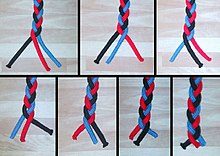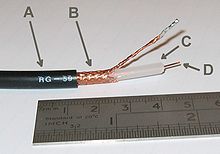Braid


A braid refer to any object created by interweaving or twinning three or more separate strands of one or more material in a diagonally overlapping pattern. Braids are commonly involved in hairstyling and rope making. Simple braids with more than three strands can be flat or tubular and generally contain an odd number of strands. Complex braids have been used to create hanging fiber artworks. A braid is similar to a plait, which covers any type of knot forming a repeated pattern.
Ropes and cables

Braiding of fiber yarn creates a strand or rope that is thicker and stronger than the strands would have been separately. Braided ropes are preferred by arborists and rock climbers because they do not twist under load, as does an ordinary twisted-strand rope. These ropes consist of one or more concentric tubular braided jackets surrounding a single untwisted yarn of straight fibers.
In fiber optics and electrical and electronic cables, braid is a tubular sheath made of braided strands of metal placed around a central cable for mechanical protection or grounding purposes. Such braids are also used after flattening for bonding large components together. The numerous smaller wires comprising the braid are much more resistant to cracking under repeated motion and vibration than is a cable of larger wires.
Similar braiding is used on pressurised rubber hoses, e.g. in plumbing and hydraulic brake systems in automobiles. Braiding is also used for fibres for composite reninforcements.
Other braids
Gold braid and silver braid are components or trims of many kinds of formal dress, including military uniform (in epaulettes, aiguillettes, on headgear).
Metaphors

Braids are often used figuratively to represent interweaving or combination, such as in "He braided many different ideas into a new whole."
Braiding happens when a river is carrying vast amounts of eroded sediment. Sediment is deposited as islands in the channel causing the river to split up into many winding channels.
In some river and stream systems, small streams join together and redivide in many places. Such stream systems are said to be braided. These are often found in alluvial fans at the outlet of canyons. This is a result of heavy sediment deposition at high flows followed by re-erosion at low flows. See also river delta.
There is also a mathematical braid theory which is closely connected with knot theory, both being subfields of topology.
